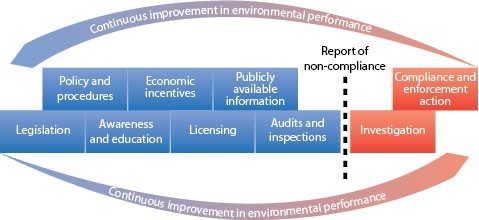Regulating native forestry
We regulate native forestry operations on both public and private land in NSW. Our compliance program aims to protect the environment while enabling the sustainable supply of native timber.
We maintain an active compliance program to protect the environment from native forestry impacts. Compliance is achieved when native forestry operations meet the requirements of all legislative and statutory frameworks, for example, they comply with the IFOAs for Crown forestry or the Codes of Practice for private native forestry (PNF).
The compliance program is used by the EPA to:
- monitor compliance with the regulatory framework
- drive improved environmental performance
- carry out enforcement action to address non-compliance.
The compliance program includes conducing environmental risk assessments of forestry operations, reviewing forestry operations plans, undertaking field inspections before harvest, during harvest and/or post-harvest, with some harvest activities inspected numerous times to ensure compliance.
We take regulatory and enforcement action where non-compliance is detected.
We publish information about forestry compliance actions and investigation outcomes.
More information on our approach to enforcement action can be found in the EPA Regulatory Policy. For further information about when and how we prosecute offences, refer to the EPA prosecution guidelines.
The EPA's powers are set out in the Biodiversity Conservation Act 2016 (BC Act). Part 11 of the BC Act lists ways the EPA can ensure compliance with the Integrated Forestry Operations Approvals, Private Native Forestry Codes of Practice and Private Native Forestry Plans. The BC Act provides the EPA with regulatory tools such as remediation directions, mandatory audits and Stop Work Orders (PDF 73KB) to encourage improved compliance and strengthen environmental protections.
The EPA promotes voluntary compliance through using:
- engagement, awareness and education activities
- a proactive audit program
- inspections
- investigations; and
- enforcement.

Components of the EPA’s regulation framework
Informing, consulting and responding to our stakeholders is a priority for the EPA. Stakeholder engagement with industry and the community is vital for driving improved environmental performance and voluntary compliance.
The EPA works with industry to make sure that legislative requirements are clearly understood and communicates the benefit of complying with legislation as well as the potential consequences of failing to do so.
The EPA provides advice on the regulatory requirements, such as on-ground advice in native forests. The EPA also runs awareness campaigns, focusing on specific environment protection issues to increase compliance and improve environmental outcomes.
The EPA has developed education materials to improve stakeholder knowledge of the compliance requirements of ecologically sustainable forest management (ESFM), including videos, guidelines and procedures for forestry operators and landholders.
The EPA’s proactive audit program uses a strategic, risk-based approach to measure industry trends and performance. Audits aim to identify good and poor forestry practices through a systematic, independent and documented procedure. The EPA conducts regular proactive audits statewide to objectively assess logging operation compliance.
Trends from audit results are analysed and help direct the EPA’s regulatory activities. Audit reports for individual Crown forestry operations are available on the Audit Report register and the EPA's public register.
The EPA inspects logging operations in native forests to assess compliance with regulatory requirements. These inspections can be in response to an environmental incident or community complaint, or to follow up on previous compliance monitoring or regulatory action.
An investigation is conducted when non-compliances have been identified. An EPA investigation may be triggered as a result of an audit or a compliance inspection, or in response to community complaints.
When compliance activities identify a non-compliance, any regulatory action taken by the EPA will aim to make sure that the environmental impacts detected are minimised, contained or repaired, and that the enforcement action reflects the seriousness of the incident and is a deterrent to re-offending.
When there is a serious breach of forestry legislation, the EPA can issue a Stop Work Order. Find out more about Stop Work Orders (PDF 71 KB).

The range of enforcement actions the EPA can take in response to a non-compliance.
Further information on the EPA’s approach to enforcement action can be found in the EPA Compliance Policy. For further information about when and how the EPA prosecutes offences, refer to the EPA prosecution guidelines.

